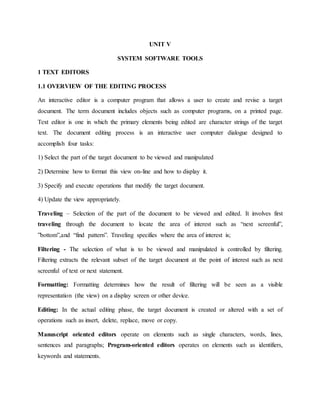The document describes the components and structure of a typical text editor. It discusses the editing process which involves selecting text, formatting views, and executing edit operations. It also covers user interface elements like input devices (keyboards, mice), output devices (screens, printers), and interaction methods (text commands, menus). The core components of an editor include the command language processor, editing component, traveling component, viewing component, display component, and buffers for editing and viewing text.





![Editing Buffer
It contains the subset of the document filtered by the editing filter based on the editing pointer
and editing filter parameters
Viewing Filter
When the display needs to be updated, the viewing component invokes the viewing filter. This
component filters the document to generate a new viewing buffer based on the current viewing
pointer as well as on the viewing filter parameters.
Viewing Buffer
It contains the subset of the document filtered by the viewing filter based on the viewing pointer
and viewing filter parameters. E.g. The user of a certain editor might travel to line 75,and after
viewing it, decide to change all occurrences of “ugly duckling” to “swan” in lines 1 through 50
of the file by using a change command such as
[1,50] c/ugly duckling/swan/
As a part of the editing command there is implicit travel to the first line of the file. Lines 1
through 50 are then filtered from the document to become the editing buffer. Successive
substitutions take place in this editing buffer without corresponding updates of the view.
In Line editors, the viewing buffer may contain the current line; in screen editors, this buffer
may contain rectangular cut out of the quarter-plane of text. This viewing buffer is then passed to
the display component of the editor, which produces a display by mapping the buffer to a
rectangular subset of the screen, usually called a window.
The editing and viewing buffers, while independent, can be related in many ways. In a simplest
case, they are identical: the user edits the material directly on the screen. On the other hand, the
editing and viewing buffers may be completely disjoint.](https://image.slidesharecdn.com/sstools-200922104247/85/Ss-tools-6-320.jpg)





